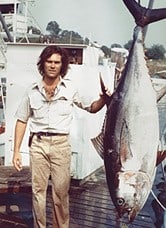September 14, 2020
Written by: Glenn Skinner
For decades, states from Texas to South Carolina have been portrayed as a sportsman’s paradise for recreational anglers. Some claim that bans of commercial fishing gears and gamefish bills in these states have created coastal Shangri-La’s where size limits are low, bag limits are high, and fish are plentiful. These same folks claim that North Carolina’s reluctance to ban commercial fishing gears or designate certain species as gamefish (prohibit commercial harvest) represents a failure of fisheries management.
Can it be this simple? Is North Carolina one legislative act away from becoming coastal fisheries?
There are those who say yes, it is this simple and they frequently compare North Carolina’s recreational regulations to those in other states as indisputable proof that we have failed to properly manage our fisheries. You would think that almost 40-years after Texas became the first state to designate Red Drum and Speckled Trout as gamefish there would be indisputable proof as to whether or not these types of regulations are or are not the solution to all of our nation’s fisheries concerns. While some claim that comparing North Carolina’s recreational bag limits to those in other states is proof we have failed. I question whether looking at bag limits alone tells the whole story. As I mentioned, Texas was the first state to declare Red Drum and Speckled Trout as gamefish in the early 1980’s. Nearly 40-years later, Texas anglers are allowed to harvest three Red Drum per day between 20 and 28 inches long and one trophy Drum during the license year with a Red Drum tag. In comparison, NC anglers are only allowed one Red Drum per day between 18-27 inches long, with no harvest of trophy fish allowed. At first glance, it would seem Texas did something right – that is if you didn’t know NC anglers had the opportunity to have similar limits but chose to be more restrictive. The fact is the Coastal Conservation Association (CCA), the same group responsible for gamefish bills and gear bans from Texas to South Carolina, supported the one fish limit in NC, and now, presents this restriction as proof of failed management.
Bag limits can be misleading, but certainly we can look at the abundance of species like Red Drum to get the answers we’re looking for, after all it’s been almost 40- years.
Unfortunately, this approach also has its limitations.
Shortly after Red Drum became a game fish, Texas partnered with the CCA to open the CCA marine Development Center in 1982. By 1983, this state-run hatchery was producing millions of Red Drum annually to be released into Texas bays. That’s right, the CCA who claimed gamefish status would save Red Drum populations was now stocking Red Drum in Texas waters!
By the late 1980’s, gillnets were banned in Texas waters. Following the ban, the numbers of Drum being released dramatically increased to over 200 million fish per year.
Since then, nearly 2.5 billion, that’s right billion with a “B”, Red Drum have been stocked into Texas waters making it nearly impossible to assess any impacts the ban may have had. The CCA successfully clouded the waters of the Gulf with hatchery reared fish while they pushed gamefish bills and gear bans northward through the Gulf and down the east coast. As other states from Louisiana to South Carolina sold out to the CCA, most began stocking programs assuring their policies would never be evaluated on their own merits. Despite the release of billions of Red Drum, there are signals of trouble as Florida’s Red Drum stocks are now showing signs of decline.
What about the other gamefish?
Speckled Trout, which have also been stocked throughout the Gulf, are definitely showing signs of trouble in every “Sportsman’s Paradise” across the Gulf of Mexico.
(https://www.tcpalm.com/story/sports/fishing-boating/2019/12/12/fwc-approves-florida-trout-regulations-go-into-effect-feb-1/4411436002/)
(https://www.al.com/sports/2019/07/state-regulations-change-next-month-on-sea-trout-and-flounder.html)
The stocking of millions of trout annually has not been enough to prevent significant declines prompting regulation changes in Texas, Louisiana, Alabama, Mississippi and Florida in recent years.
Current size limits in Texas, Alabama, and Florida are more restrictive than North Carolinas 14 inch limit. Their bag limits, which range from two to six Trout per day are similar to NC’s four Trout daily bag limit. Louisiana and Mississippi both still have very liberal size and bag limits for Speckled Trout, but again, bag limits can be very misleading.
Louisiana has maintained a twenty five Trout per day limit, despite the fact that the spawning stock biomass for Speckled Trout is currently at the lowest level they have ever seen in the 38 years they have been collecting data on the species.
When the Louisiana Department of Wildlife and Fisheries presented their concerns to the public and commission members in 2019, Louisiana CCA Director, David Cresson was quoted as saying, “We need to see more information before rushing into any judgements.” If this were occurring in NC, where gillnets are allowed, the CCA would demand immediate action! This was recently the case in North Carolina’s Southern Flounder fishery which has been declining in recent years despite several regulatory changes meant to rebuild the stock. The most recent assessment for Southern Flounder showed that the stock from NC to Florida was overfished, and harvest needed to be reduced to allow rebuilding. The CCA seized the moment and took full advantage of every opportunity to publicly condemn NC commercial fishermen and their nets as the sole cause of overfishing. North Carolina’s commercial removals make up 36.29% of the total number of flounder removed from the stock. South Carolina, Georgia, and Florida’s commercial industries only represent 2.59% combined.
http://www.laflyfish.com/2019/09/speckled-trout-in-trouble-and-changes.html
In comparison, the recreational fisheries in Florida (31.64%), South Carolina (14.65%), North Carolina (11.72%), and Georgia (3.42%) of the total number of fish removed respectively for a total of 61%
The CCA and their supporters were quick to point out the high percentage of commercial removals from NC, but failed to mention Florida anglers were having a similar impact. They also failed to mention that Southern Flounder stocks are declining throughout their entire U. S. range from NC to Texas. That’s right, like Speckled Trout, Southern Flounder are struggling throughout the Gulf despite decades without an extensive inshore gillnet fishery. Texas, which again has not allowed gillnetting since the late 1980’s, has raised size limits and lowered bag limits several times attempting to slow the decline, but like NC, their efforts have fallen short. You would think the Texas CCA would be ranting and raving over this “failure of fisheries management”, but you would be wrong. Instead, they blame warm winters, and acknowledge that they may never see Flounder in the numbers they saw in the 1980’s again.
Meanwhile, back in NC where gillnets are allowed, the CCA claims overharvest by commercial fishermen has destroyed the stock and we are attempting to build the stock to a level we have never seen before!
http://www.floridasportsman.com/2020/07/19/approved-changes-flounder-regulations/
http://ccatexas.org/southern-flounder-struggles/
The sad truth is no matter what gears are removing fish from the stock when the total number of fish being removed exceed what’s being reproduced for an extended period of time, you’ve got trouble. Whether or not you sell a fish, take it home to eat, or it dies after being released, it’s a removal from the stock and the combined impacts are more important than who or what gear is responsible.
Another very sad truth is gamefish bills and gear bans are not management strategies, they are pollical .strategies meant to reallocate the resource, not conserve it.
Sadder yet is the fact that these pollical strategies have devastated fishing families and their communities for decades with little to no quantifiable benefit to fish stocks. There are those who say North Carolina should look to the South when determining how best to manage our fisheries, I agree! We should take a very close look at what these other states have done in order to avoid making the same mistakes! Whether it be a gamefish bill, gear ban, or giving the WRC authority to manage our coastal fisheries, one thing is certain, North Carolina is not simply one legislative act away from becoming coastal fisheries!
With that question answered, here are some other questions we should be asking.
- Why has almost every state that banned gillnets and inshore trawling started fish stocking programs?
- What would their fisheries look like if they had not released billions of hatchery reared fish to supplement wild stocks?
- Could the CCA have pushed their agenda so far if they had let their policies stand alone without the cover of stocking billions of fish provided?
There’s no doubt that like North Carolina, the Gulf States are truly a “Sportsman’s Paradise”. There’s no doubt that the CCA’s policies did not and will not prevent future troubles in paradise.
The next time someone tells you “the anglers grass is greener” in other states, do some research and you will quickly see their claims are fertilizer than fact!
Related Articles
The Saga of Southern Flounder
Related Articles Stay Up to Date With The Latest News & Updates Join Our Newsletter
The Saga of Southern Flounder; The Rest of the Story…
Related Articles Stay Up to Date With The Latest News & Updates Join Our Newsletter
Southern Flounder, by the Numbers
Related Articles Stay Up to Date With The Latest News & Updates Join Our Newsletter

